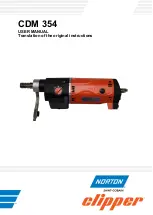
6
English
Torque Limiting Clutch
All rotary hammerdrills are equipped with a torque limiting
clutch that reduces the maximum torque reaction transmitted
to the operator in case of jamming of a drill bit. This feature
also prevents the gearing and electric motor from stalling.
The torque limiting clutch has been factory-set and cannot
be adjusted.
ASSEMBLY AND ADJUSTMENTS
WARNING: To reduce the risk of serious personal
injury, turn tool off and disconnect tool from power
source before making any adjustments or removing/
installing attachments or accessories.
Be sure the
trigger switch is in the OFF position. An accidental start-up
can cause injury.
Selecting the Operating Mode (Fig. B)
The tool can be used in the following operating modes:
Rotary drilling: for screwdriving and for drilling
into steel, wood and plastics
Hammerdrilling: for concrete and masonry
drilling operations.
Bit rotation: non-working position used only to
rotate a flat chisel into the desired position
Hammering only: for light chipping, chiselling
and demolition applications. In this mode the
tool can also be used as a lever to free a jammed
drill bit.
1. To select the operating mode, press the mode selector
button
5
and rotate the mode selector switch
4
until it
points to the symbol of the required mode.
2. Release the mode selector button and check that the mode
selector switch is locked in place.
WARNING:
Do not select the operating mode when the
tool is running.
Indexing the Chisel Position (Fig. B)
The chisel can be indexed and locked into different positions.
1. Press the mode selector button
5
and rotate the mode
selector switch
4
until it points to the “bit rotation/
hammerdrilling” position.
2. Rotate the chisel to the desired position.
3. Set the mode selector switch
4
to the “hammering
only” position.
4. Twist the chisel until it locks in position.
Inserting and Removing SDS Plus Accessories
(Fig. C)
This tool uses SDS Plus accessories (refer to the inset in Fig. C for
a cross-section of an SDS Plus bit shank). We recommend using
professional accessories only.
1. Clean and grease the bit shank.
2. Insert the bit shank into the SDS Plus tool holder
6
.
3. Push the bit down and turn it slightly until it fits into
the slots.
4. Pull on the bit to check if it is properly locked. The
hammering function requires the bit to be able to move
axially several centimetres when locked in the tool holder.
5. To remove a bit, pull back the tool holder sleeve
10
and
pull out the bit.
WARNING:
Always wear gloves when you change
accessories. The exposed metal parts on the tool and
accessory may become extremely hot during operation.
Fitting the Side Handle (Fig. D)
The side handle
8
can be fitted to suit both right-handed and
left-handed users.
WARNING:
Do not use the tool without the side handle
properly assembled.
1. Loosen the side handle.
2.
For right-handed users:
Slide the side handle clamp over
the collar behind the tool holder, handle at the left.
For left-handed-users:
Slide the side handle clamp over
the collar behind the tool holder, handle at the right.
3. Rotate the side handle to the desired position and tighten
the handle.
Setting the Drilling Depth (Fig. E)
1. Insert the required drill bit as described above.
2. Press the depth rod button
9
and keep it depressed.
3. Fit the depth adjustment rod
7
through the hole in the
depth stop clamp.
4. Adjust the drilling depth as shown.
5. Release the depth stop clamp.
Reversing Lever (Fig. F)
The forward/reverse lever
3
is used to reverse the rotation of
the hammer for backing out fasteners or jammed bits in the
drill-only function.
CAUTION:
When reversing to clear jammed bits, be ready
for strong reactive torque.
To reverse the hammer, turn it off and align the forward/reverse
lever
3
with the yellow arrow pointing backward.
To position the lever for forward operation, turn the hammer
off and align the forward/reverse lever
3
with the yellow arrow
pointing forward.
Fitting the Chuck Adapter and Chuck
Optional Accessory
1. Screw the chuck onto the threaded end of the
chuck adapter.
2. Insert the connected chuck and adapter in the tool as
though it were a standard SDS Plus bit.
3. To remove the chuck, proceed as for removing a standard
SDS Plus bit.
WARNING:
Never use standard chucks in the
hammerdrilling mode.









































